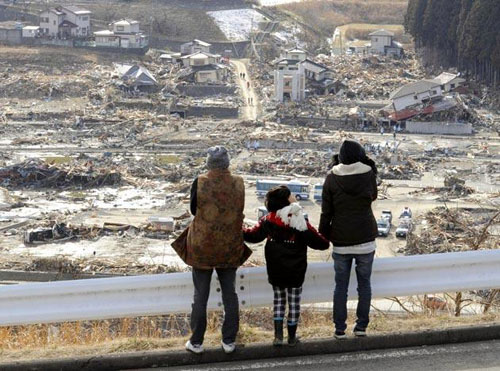“There is a sacredness in tears. They are not the mark of weakness, but of power. They speak more eloquently than ten thousand tongues. They are messengers of overwhelming grief…and unspeakable love.” – Washington Irving

As Kumagi walks through his town, he stares in wonder at the destruction around him.
“Is it real or is it a movie?” he wonders. “I wish this were just a movie and it would end.”
I know the analogy all too well. I said the exact same thing as I saw medical personnel hover around my unconscious son. As I watched my dying son being attended to, I had to look from person to person, wondering if this was actually happening. There were no tears and screams. I just stood there , dumbfounded unable to move.
I cannot imagine the horror that these survivors feel right now. They are surrounded by multiple crises.
The Japanese people are slowly returning to their ravaged homes to sift through the rubble and see what they can salvage. Sadly, there is nothing but destruction as far as the eye can see. But they pick up pieces here and there, even cleaning the mess around their homes. It is therapeutic to do so, as if doing so can bring some normal semblance to reality. It is part of the healing process.

Nakamura said he hopes the government can do more to help them cope with the enormity of the disaster.
““I really don’t know what we can do. But when a disaster is this big, everybody needs help so we can’t really ask for individual help. But a few officials are here today, so we’ll discuss things with them and think of the next step and somehow survive,” he said, wiping away his tears.
These survivors of the deadly 8.9-magnitude earthquake and subsequent tsunami are coping with multiple crises: loss of family members, loss of homes, fear about radiation exposure.
Media keeps portraying them as “stoical way its people cope with unimaginable adversity.”
A woman weeps quietly but covers her face to hide her emotions from the prying camera. She was looking for her mother’s house, but its gone, along with half her town.
I think we should not judge how these survivors feel. Really how can you tell what is on their mind.
There’s no anger, no blame, she feels no need to highlight what a personal tragedy this clearly is.
Even if they look composed, they are grieving inside. There is nothing wrong about keeping these feelings in check because that is their process. Ben, another survivor points out there is no time for grief. In such a time of an unimaginable disaster, they have not yet had the time to feel grief, sadness and anger. Displaying no emotions is also part of the grief process under “denial”, where feelings are numbed to be able to function. It is a normal body response to adjust to the newfound reality. The feelings of anger and extreme sadness will follow after the body adjusts to the impact of the loss.
Western news team search the wreckage for images of fear and anguish, for outrage and despair, but the Japanese survivors turn their faces away and cover their eyes if they weep.
This extraordinary stoicism can be summed up by the Japanese word gaman, a concept that defies easy translation but broadly means calm forbearance, perseverance and poise in the face of adverse events beyond one’s control.
Gaman is part of the glue that holds Japanese society together, a way of thought instilled from an early age. It implies self-restraint, suffering in silence, denying oneself gratification and self-expression to fit in with the greater good. It signifies self-denial, solidarity and a certain patient fatalism.
Let us remember that grief is a necessary and ultimately healthy process. Unfortunately, people who lose family and friends to disasters may be at an increased risk of a disorder known as traumatic or complicated grief.
The thing is experts fear widespread post-traumatic stress disorder (PTSD) among survivors in Japan’s devastating earthquake and tsunami.
Dr. Rey Lesaca, a psychiatrist for 34 years, believes there is no such thing as being strong in a post traumatic stress disorder. It will happen to survivors whether they like it or not. “Symptoms of PTSD include anxiety, palpitations, clammy hands, shaking/shivering, insomnia, bouts of crying. This is an emotional, mental, psychological disorder as well as biological imbalance.”
Ai Matsuhashi is showing signs of post-traumatic shock. “I can’t sleep. I feel like the world is shaking all the time. I heard that is normal after a big earthquake, but I’m still worried.”
Indeed they are coping in ways that some find hard to relate to: with deep sadness, but without loud wailing or anger. Even if the Japanese are known for their resiliency I can only hope they are given the needed assistance as they embark on their new reality.
My heart goes out to everyone in Japan. I know you will be able to bounce back but I know too, that it is not an easy journey.